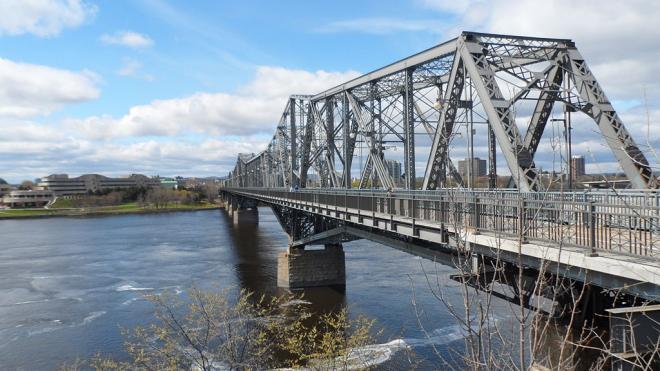Ottawa Citizen | Opinion, By George Bruce Levine
The future of the 120-year-old Alexandra Bridge across the Ottawa River has been the subject of several scenarios, none of which presents a clear winner. Each view so far has featured one element of the problem in isolation. A strategic analysis might provide a more practical and less costly solution for getting people across the river.
Let’s begin with an inventory of the six bridges that span the river. Three of them — the Macdonald-Cartier, Portage and Champlain bridges — are “beam bridges,” which carry a roadway on massive girders. The first two of this type each provide six lanes for traffic, three in each direction, while the Champlain Bridge carries three lanes, with two in each direction. This asymmetry is caused by a reversing lane, which carries traffic in one direction or the other during peak periods.
The Alexandra and Chaudière bridges are of the “steel-truss type,” each carrying only two traffic lanes, and the disused Prince of Wales Bridge, which carried a railway across the river until 2007, is also of this structural type.
Together, these bridges provide 19 automobile traffic lanes, 10 in either direction. If the reversing-lane system — the one used on the Champlain Bridge — were implemented on both the Macdonald-Cartier and Portage bridges, there would be total of 12 automobile lanes available at peak times. This would be a very cost-effective way to increase the overall capacity of our bridges, and it would allow the closure to automobile traffic of the Alexandra Bridge.
Now let’s consider the future of the Alexandra Bridge without cars. This venerable bridge was built primarily to carry mainline trains and the Hull Electric Railway across the Ottawa River, as well as some horse-drawn and motorized vehicles. The railway continued south along a ledge below Major’s Hill Park, to the Château Laurier hotel and Union Station. The return to this pattern of use would allow the new Gatineau Tramway to cross the Alexandra Bridge, taking STO passengers to the most prominent crossroads in Ottawa, where Rideau and Wellington streets intersect with Sussex and Colonel By drives. The visual impact of a tramway “terminus” there would be enhanced by using the former photography museum pavilion One Wellington St. as its public entrance. What’s old is new again!
But the STO tramway system would still need a “transfer station” where its passengers could gain direct access to the O-Train system. A new tramway station adjacent to OC Transpo’s Bayview Station would be well suited for this purpose, with the Trillium Line carrying passengers from there south, and the Confederation Line carrying passengers both east and west across Ottawa. This is the obvious crossroads for the O-Train and tramway systems, providing STO passengers single-transfer access to the entire O-Train system.
Neither the development of the “terminus’ at One Wellington St. nor the “transfer station” adjacent to Bayview Station would require ripping up busy streets, boring tunnels, risking geological surprises (sinkholes), or massive investment. The major civil engineering work has already been done and awaits imaginative use.
Furthermore, this approach would satisfy our desire to conserve our heritage railway bridges, while providing environmentally friendly transit and active pathways, all at a fraction of the cost of some of the options currently under consideration.
There are four key elements to this strategy: 1) optimization of existing road bridges by installing more reversing lanes; 2) maintenance of automobile traffic on the Portage Bridge; 3) use of the Alexandra and Prince of Wales bridges to carry people across the Ottawa River in trams rather than in cars; and 4) creation of specialized tramway stations at One Wellington St. and the Bayview O-Train station to serve cross-river commuters.
George Bruce Levine holds degrees in architecture and design methodology and has consulted on pre-design project planning in Ottawa. He formerly contributed articles to the Citizen’s “Cityscape” column. He is a member of Heritage Ottawa and a supporter of the Alexandra Bridge Coalition, though the opinions expressed here are his own.
